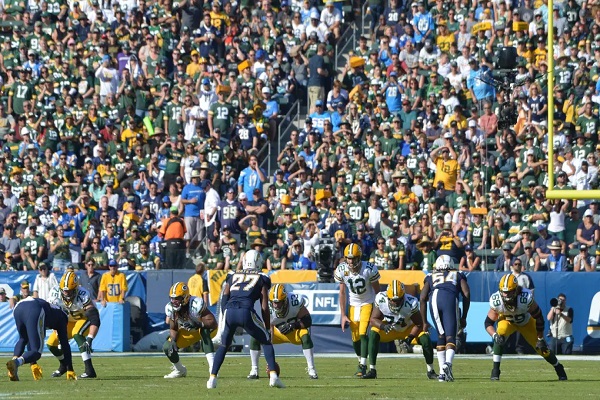Football
In Los Angeles and around the NFL, away fans are taking over

In Los Angeles and around the NFL, away fans are taking over
This week the Chargers’ owner denied his team will relocate to London. But such rumors are unsurprising when home support struggles.
The Los Angeles Chargers returned to southern California on Sunday after playing the previous two weeks on the road, but it didn’t make much difference. Home-field advantage doesn’t really apply to the Chargers, not when visiting fans routinely make the team feel like they’re behind enemy lines in their own stadium.
That was the case again on Sunday, when the Chargers hosted the Green Bay Packers. The predominant color in the stands was the green of the visitors, and the cheers rang out louder for Aaron Rodgers than Philip Rivers. The home team won, convincingly at that, but most people left the stadium disappointed.
It has become one of the peculiar features of the NFL calendar since both the Chargers and Rams relocated to Los Angeles in 2017, marking a reunion between America’s second-largest market and its most popular sporting league: more often than not, the teams’ home games look and sound like home games for the opposition.
Chargers players were showered with boos when they took the field against the visiting Philadelphia Eagles two years ago. The Rams got the same treatment last season at home against the Packers.
Both Rivers, the Chargers quarterback, and Rams quarterback Jared Goff have regularly been forced to use a silent count to combat the noise generated by the away side’s fans, typically an unnecessary measure to take for a team playing at home.
“It’s certainly not ideal,” Rivers said with a hint of resignation after the 2017 game against the Eagles. The home-field hostility hit a fresh apex for both teams on the same Sunday last month.
That afternoon, the Rams were overwhelmed on the field and in the stands, which were blanketed by the red of the visiting San Francisco 49ers. “This turned into a home game pretty quickly,” said San Francisco quarterback Jimmy Garoppolo after the game. “I’ve never seen anything like it.”
It hasn’t been quite as enjoyable for the ostensible home teams. A few hours later that day, the Chargers hosted the Pittsburgh Steelers, whose fans roared with approval when the stadium PA system blasted their team’s adopted anthem, Renegade by Styx.
It was supposed to be a gag; the song eventually transitioned to Never Gonna Give You Up by Rick Astley, the punctuation to a long-running internet prank. But the joke didn’t land, and Chargers players were miffed.
“It was crazy,” Chargers running back Melvin Gordon said. “They started playing [the Steeelers’] theme music. I don’t know what we were doing – that little soundtrack, what they do on their home games.
I don’t know why we played that.” Chargers offensive lineman Forrest Lamp was more blunt: “We’re used to not having any fans here. It does suck, though, when they’re playing their music in the fourth quarter. We’re the ones at home. I don’t know who’s in charge of that, but they probably should be fired.”
The go-to line from Rams and Chargers brass is that it will take time to cultivate a true fan base in Los Angeles.
Chargers owner Dean Spanos, who engineered the franchise’s move from San Diego after voters there rejected his bid for public funding of a new stadium, told the New York Times earlier this year that it will “take maybe a generation” for the team to find its footing in LA.
On Tuesday this week, he was forced to deny rumors the team has discussed relocating to London.
The two Los Angeles teams have varying histories in the city. The Chargers played their inaugural season there in 1960 before decamping for San Diego, where they remained for 56 years.
The Rams have deeper roots in Los Angeles, playing in the area for 48 years beginning in 1946. But in 1995, the Rams moved to St Louis and the Raiders went up the coast to Oakland, leaving LA without an NFL franchise.
“It’s going to take us some time to build the fan base back up again,” said Ralph Valdez, the president and founder of the So Cal Rams Booster Club. “The Rams were gone for 21 years, and there were a lot of people who were left without a team to follow.”
Valdez started the group in 2004, when the Rams were just four years removed from winning a Super Bowl in St Louis, but he has been a fan since watching the team as a kid in the 1960s.
“Once I saw the horns on the helmet, I was like, I’m gonna follow them for the rest of my life,” he said. “They could be in Egypt. That’s still going to be my team.”
Both LA teams are currently playing in temporary home stadiums – the Rams at the Los Angeles Memorial Coliseum, the permanent home of the University of Southern California’s football team; the Chargers at the 27,000-seat Dignity Health Sports Park, which serves as the home for the Los Angeles Galaxy of Major League Soccer – before moving to the $5bn SoFi Stadium in the suburb of Inglewood next year.
There is hope that the opening of the stadium, which will host the Super Bowl in 2022 and is expected to host the main opening ceremony for the 2028 Summer Olympics, will deepen the bond between the teams and the city.
“When we get to Inglewood, that’s our home. That’s the Rams’ opportunity to start gathering new fans,” Valdez said.
“When you have a home, you can build something.”
He added: “In 10 or 15 years, you’re still going to have fans of other teams [in Los Angeles].
But their kids, their grandkids, I would expect them to be Rams fans.”
Perhaps. But to some outside observers, the recurring sight of away fans swarming Chargers and Rams home games has made the NFL’s return to Los Angeles look frivolous.
“Zero teams in Los Angeles – that wasn’t enough. Two’s clearly too many,” said ESPN anchor Scott Van Pelt in a commentary that aired last month.
“There are NFL fans in Los Angeles, plenty of them. Most of them just root for other teams. And they’re going to have a fancy new place to see them play when they come to town.”
The Chargers and Rams are not only contending with lost time in their bid to attract fans. With the proliferation of apps like SeatGeek and StubHub, through which customers can easily buy and resell tickets, the away fan takeover has become ubiquitous – and not just in Los Angeles.
Fans of the Minnesota Vikings flooded Arrowhead Stadium on Sunday for the team’s away game against the Kansas City Chiefs, generating as much noise as the home supporters and performing their signature “skol” chant with impunity.
New England Patriots fans turned out in droves for the team’s road game last month against Washington; they did the same two weeks later when the Patriots played at the New York Jets.
When iconic teams like the Patriots, Steelers, Packers or Dallas Cowboys come to town, whether in Los Angeles or elsewhere, the home fans are always at risk of being outnumbered.
Resale ticket prices are an average of 53% higher than a typical game when the Packers are visiting, according to figures provided by SeatGeek. They are 55% higher for Cowboys road games. That can be enticing for a season-ticket holder, looking to resell a ticket.
Johnny Abundez, a member of the Chargers fan group Bolt Pride who lives in the San Diego area, expected Packers fans to account for about 80% of attendees at Sunday’s game, a projection that was easily corroborated both by those at the stadium and those watching on television.
“I know Chargers fans who sold cheap seats for $350 to that game,” Abundez said. “I’m not one to judge. I know a lot of Chargers fans who like watching the game on TV.”
Abundez said that southern California, with its high concentration of transplants and warm climate, is particularly vulnerable to the away fan takeover.
New York Yankees fans turned out en masse for the team’s road trip against the Los Angeles Dodgers in August. And while the Los Angeles Clippers are NBA contenders now, the team’s home games have long attracted throngs of visiting fans.
It happened frequently to the Chargers in San Diego, too. “San Diego is a military community,” Abundez said. “And once it gets to this time of the year, you see snow and rain in the Midwest and on the East Coast, and we have beautiful weather out here.”
For Valdez, however, the secondary ticket market has been a source of frustration. His Rams group encourages members to sell to supporters of the home team.
“I don’t understand people who call themselves Rams fans and who are selling their tickets to make a premium,” Valdez said. “We tell them that if they’re going to sell them, sell them to Rams fans.”In Los Angeles and around the NFL, away fans are taking over
This week the Chargers’ owner denied his team will relocate to London. But such rumors are unsurprising when home support struggles.
The Los Angeles Chargers returned to southern California on Sunday after playing the previous two weeks on the road, but it didn’t make much difference.
Home-field advantage doesn’t really apply to the Chargers, not when visiting fans routinely make the team feel like they’re behind enemy lines in their own stadium.
That was the case again on Sunday, when the Chargers hosted the Green Bay Packers. The predominant color in the stands was the green of the visitors, and the cheers rang out louder for Aaron Rodgers than Philip Rivers.
The home team won, convincingly at that, but most people left the stadium disappointed.
It has become one of the peculiar features of the NFL calendar since both the Chargers and Rams relocated to Los Angeles in 2017, marking a reunion between America’s second-largest market and its most popular sporting league: more often than not, the teams’ home games look and sound like home games for the opposition. Chargers players were showered with boos when they took the field against the visiting Philadelphia Eagles two years ago. The Rams got the same treatment last season at home against the Packers. Both Rivers, the Chargers quarterback, and Rams quarterback Jared Goff have regularly been forced to use a silent count to combat the noise generated by the away side’s fans, typically an unnecessary measure to take for a team playing at home.
“It’s certainly not ideal,” Rivers said with a hint of resignation after the 2017 game against the Eagles. The home-field hostility hit a fresh apex for both teams on the same Sunday last month. That afternoon, the Rams were overwhelmed on the field and in the stands, which were blanketed by the red of the visiting San Francisco 49ers. “This turned into a home game pretty quickly,” said San Francisco quarterback Jimmy Garoppolo after the game. “I’ve never seen anything like it.”
It hasn’t been quite as enjoyable for the ostensible home teams. A few hours later that day, the Chargers hosted the Pittsburgh Steelers, whose fans roared with approval when the stadium PA system blasted their team’s adopted anthem, Renegade by Styx. It was supposed to be a gag; the song eventually transitioned to Never Gonna Give You Up by Rick Astley, the punctuation to a long-running internet prank. But the joke didn’t land, and Chargers players were miffed.
“It was crazy,” Chargers running back Melvin Gordon said. “They started playing [the Steeelers’] theme music. I don’t know what we were doing – that little soundtrack, what they do on their home games. I don’t know why we played that.” Chargers offensive lineman Forrest Lamp was more blunt: “We’re used to not having any fans here. It does suck, though, when they’re playing their music in the fourth quarter. We’re the ones at home. I don’t know who’s in charge of that, but they probably should be fired.”
The go-to line from Rams and Chargers brass is that it will take time to cultivate a true fan base in Los Angeles. Chargers owner Dean Spanos, who engineered the franchise’s move from San Diego after voters there rejected his bid for public funding of a new stadium, told the New York Times earlier this year that it will “take maybe a generation” for the team to find its footing in LA. On Tuesday this week, he was forced to deny rumors the team has discussed relocating to London.
The two Los Angeles teams have varying histories in the city. The Chargers played their inaugural season there in 1960 before decamping for San Diego, where they remained for 56 years. The Rams have deeper roots in Los Angeles, playing in the area for 48 years beginning in 1946. But in 1995, the Rams moved to St Louis and the Raiders went up the coast to Oakland, leaving LA without an NFL franchise.
“It’s going to take us some time to build the fan base back up again,” said Ralph Valdez, the president and founder of the So Cal Rams Booster Club. “The Rams were gone for 21 years, and there were a lot of people who were left without a team to follow.”
Valdez started the group in 2004, when the Rams were just four years removed from winning a Super Bowl in St Louis, but he has been a fan since watching the team as a kid in the 1960s. “Once I saw the horns on the helmet, I was like, I’m gonna follow them for the rest of my life,” he said. “They could be in Egypt. That’s still going to be my team.”
Both LA teams are currently playing in temporary home stadiums – the Rams at the Los Angeles Memorial Coliseum, the permanent home of the University of Southern California’s football team; the Chargers at the 27,000-seat Dignity Health Sports Park, which serves as the home for the Los Angeles Galaxy of Major League Soccer – before moving to the $5bn SoFi Stadium in the suburb of Inglewood next year.
There is hope that the opening of the stadium, which will host the Super Bowl in 2022 and is expected to host the main opening ceremony for the 2028 Summer Olympics, will deepen the bond between the teams and the city.
“When we get to Inglewood, that’s our home. That’s the Rams’ opportunity to start gathering new fans,” Valdez said. “When you have a home, you can build something.”
He added: “In 10 or 15 years, you’re still going to have fans of other teams [in Los Angeles]. But their kids, their grandkids, I would expect them to be Rams fans.”
Perhaps. But to some outside observers, the recurring sight of away fans swarming Chargers and Rams home games has made the NFL’s return to Los Angeles look frivolous. “Zero teams in Los Angeles – that wasn’t enough. Two’s clearly too many,” said ESPN anchor Scott Van Pelt in a commentary that aired last month.
“There are NFL fans in Los Angeles, plenty of them. Most of them just root for other teams. And they’re going to have a fancy new place to see them play when they come to town.”
The Chargers and Rams are not only contending with lost time in their bid to attract fans. With the proliferation of apps like SeatGeek and StubHub, through which customers can easily buy and resell tickets, the away fan takeover has become ubiquitous – and not just in Los Angeles.
Fans of the Minnesota Vikings flooded Arrowhead Stadium on Sunday for the team’s away game against the Kansas City Chiefs, generating as much noise as the home supporters and performing their signature “skol” chant with impunity. New England Patriots fans turned out in droves for the team’s road game last month against Washington; they did the same two weeks later when the Patriots played at the New York Jets.
When iconic teams like the Patriots, Steelers, Packers or Dallas Cowboys come to town, whether in Los Angeles or elsewhere, the home fans are always at risk of being outnumbered. Resale ticket prices are an average of 53% higher than a typical game when the Packers are visiting, according to figures provided by SeatGeek. They are 55% higher for Cowboys road games. That can be enticing for a season-ticket holder, looking to resell a ticket.
Johnny Abundez, a member of the Chargers fan group Bolt Pride who lives in the San Diego area, expected Packers fans to account for about 80% of attendees at Sunday’s game, a projection that was easily corroborated both by those at the stadium and those watching on television.
“I know Chargers fans who sold cheap seats for $350 to that game,” Abundez said. “I’m not one to judge. I know a lot of Chargers fans who like watching the game on TV.”
Abundez said that southern California, with its high concentration of transplants and warm climate, is particularly vulnerable to the away fan takeover. New York Yankees fans turned out en masse for the team’s road trip against the Los Angeles Dodgers in August. And while the Los Angeles Clippers are NBA contenders now, the team’s home games have long attracted throngs of visiting fans. It happened frequently to the Chargers in San Diego, too. “San Diego is a military community,” Abundez said.
“And once it gets to this time of the year, you see snow and rain in the Midwest and on the East Coast, and we have beautiful weather out here.”
For Valdez, however, the secondary ticket market has been a source of frustration. His Rams group encourages members to sell to supporters of the home team.
“I don’t understand people who call themselves Rams fans and who are selling their tickets to make a premium,” Valdez said. “We tell them that if they’re going to sell them, sell them to Rams fans.”In Los Angeles and around the NFL, away fans are taking over
This week the Chargers’ owner denied his team will relocate to London. But such rumors are unsurprising when home support struggles.
The Los Angeles Chargers returned to southern California on Sunday after playing the previous two weeks on the road, but it didn’t make much difference. Home-field advantage doesn’t really apply to the Chargers, not when visiting fans routinely make the team feel like they’re behind enemy lines in their own stadium.
That was the case again on Sunday, when the Chargers hosted the Green Bay Packers. The predominant color in the stands was the green of the visitors, and the cheers rang out louder for Aaron Rodgers than Philip Rivers. The home team won, convincingly at that, but most people left the stadium disappointed.
It has become one of the peculiar features of the NFL calendar since both the Chargers and Rams relocated to Los Angeles in 2017, marking a reunion between America’s second-largest market and its most popular sporting league: more often than not, the teams’ home games look and sound like home games for the opposition.
Chargers players were showered with boos when they took the field against the visiting Philadelphia Eagles two years ago. The Rams got the same treatment last season at home against the Packers. Both Rivers, the Chargers quarterback, and Rams quarterback Jared Goff have regularly been forced to use a silent count to combat the noise generated by the away side’s fans, typically an unnecessary measure to take for a team playing at home.
“It’s certainly not ideal,” Rivers said with a hint of resignation after the 2017 game against the Eagles. The home-field hostility hit a fresh apex for both teams on the same Sunday last month. That afternoon, the Rams were overwhelmed on the field and in the stands, which were blanketed by the red of the visiting San Francisco 49ers.
“This turned into a home game pretty quickly,” said San Francisco quarterback Jimmy Garoppolo after the game. “I’ve never seen anything like it.”
It hasn’t been quite as enjoyable for the ostensible home teams. A few hours later that day, the Chargers hosted the Pittsburgh Steelers, whose fans roared with approval when the stadium PA system blasted their team’s adopted anthem, Renegade by Styx. It was supposed to be a gag; the song eventually transitioned to Never Gonna Give You Up by Rick Astley, the punctuation to a long-running internet prank. But the joke didn’t land, and Chargers players were miffed.
“It was crazy,” Chargers running back Melvin Gordon said. “They started playing [the Steeelers’] theme music. I don’t know what we were doing – that little soundtrack, what they do on their home games. I don’t know why we played that.” Chargers offensive lineman Forrest Lamp was more blunt: “We’re used to not having any fans here. It does suck, though, when they’re playing their music in the fourth quarter. We’re the ones at home. I don’t know who’s in charge of that, but they probably should be fired.”
The go-to line from Rams and Chargers brass is that it will take time to cultivate a true fan base in Los Angeles. Chargers owner Dean Spanos, who engineered the franchise’s move from San Diego after voters there rejected his bid for public funding of a new stadium, told the New York Times earlier this year that it will “take maybe a generation” for the team to find its footing in LA. On Tuesday this week, he was forced to deny rumors the team has discussed relocating to London.
The two Los Angeles teams have varying histories in the city. The Chargers played their inaugural season there in 1960 before decamping for San Diego, where they remained for 56 years. The Rams have deeper roots in Los Angeles, playing in the area for 48 years beginning in 1946. But in 1995, the Rams moved to St Louis and the Raiders went up the coast to Oakland, leaving LA without an NFL franchise.
“It’s going to take us some time to build the fan base back up again,” said Ralph Valdez, the president and founder of the So Cal Rams Booster Club. “The Rams were gone for 21 years, and there were a lot of people who were left without a team to follow.”
Valdez started the group in 2004, when the Rams were just four years removed from winning a Super Bowl in St Louis, but he has been a fan since watching the team as a kid in the 1960s. “Once I saw the horns on the helmet, I was like, I’m gonna follow them for the rest of my life,” he said. “They could be in Egypt. That’s still going to be my team.”
Both LA teams are currently playing in temporary home stadiums – the Rams at the Los Angeles Memorial Coliseum, the permanent home of the University of Southern California’s football team; the Chargers at the 27,000-seat Dignity Health Sports Park, which serves as the home for the Los Angeles Galaxy of Major League Soccer – before moving to the $5bn SoFi Stadium in the suburb of Inglewood next year. There is hope that the opening of the stadium, which will host the Super Bowl in 2022 and is expected to host the main opening ceremony for the 2028 Summer Olympics, will deepen the bond between the teams and the city.
“When we get to Inglewood, that’s our home. That’s the Rams’ opportunity to start gathering new fans,” Valdez said. “When you have a home, you can build something.”
He added: “In 10 or 15 years, you’re still going to have fans of other teams [in Los Angeles]. But their kids, their grandkids, I would expect them to be Rams fans.”
Perhaps. But to some outside observers, the recurring sight of away fans swarming Chargers and Rams home games has made the NFL’s return to Los Angeles look frivolous. “Zero teams in Los Angeles – that wasn’t enough. Two’s clearly too many,” said ESPN anchor Scott Van Pelt in a commentary that aired last month. “There are NFL fans in Los Angeles, plenty of them. Most of them just root for other teams. And they’re going to have a fancy new place to see them play when they come to town.”
The Chargers and Rams are not only contending with lost time in their bid to attract fans. With the proliferation of apps like SeatGeek and StubHub, through which customers can easily buy and resell tickets, the away fan takeover has become ubiquitous – and not just in Los Angeles.
Fans of the Minnesota Vikings flooded Arrowhead Stadium on Sunday for the team’s away game against the Kansas City Chiefs, generating as much noise as the home supporters and performing their signature “skol” chant with impunity. New England Patriots fans turned out in droves for the team’s road game last month against Washington; they did the same two weeks later when the Patriots played at the New York Jets.
When iconic teams like the Patriots, Steelers, Packers or Dallas Cowboys come to town, whether in Los Angeles or elsewhere, the home fans are always at risk of being outnumbered. Resale ticket prices are an average of 53% higher than a typical game when the Packers are visiting, according to figures provided by SeatGeek. They are 55% higher for Cowboys road games. That can be enticing for a season-ticket holder, looking to resell a ticket.
Johnny Abundez, a member of the Chargers fan group Bolt Pride who lives in the San Diego area, expected Packers fans to account for about 80% of attendees at Sunday’s game, a projection that was easily corroborated both by those at the stadium and those watching on television.
“I know Chargers fans who sold cheap seats for $350 to that game,” Abundez said. “I’m not one to judge. I know a lot of Chargers fans who like watching the game on TV.”
Abundez said that southern California, with its high concentration of transplants and warm climate, is particularly vulnerable to the away fan takeover. New York Yankees fans turned out en masse for the team’s road trip against the Los Angeles Dodgers in August. And while the Los Angeles Clippers are NBA contenders now, the team’s home games have long attracted throngs of visiting fans. It happened frequently to the Chargers in San Diego, too.
“San Diego is a military community,” Abundez said. “And once it gets to this time of the year, you see snow and rain in the Midwest and on the East Coast, and we have beautiful weather out here.”
For Valdez, however, the secondary ticket market has been a source of frustration. His Rams group encourages members to sell to supporters of the home team.
“I don’t understand people who call themselves Rams fans and who are selling their tickets to make a premium,” Valdez said. “We tell them that if they’re going to sell them, sell them to Rams fans.”
































